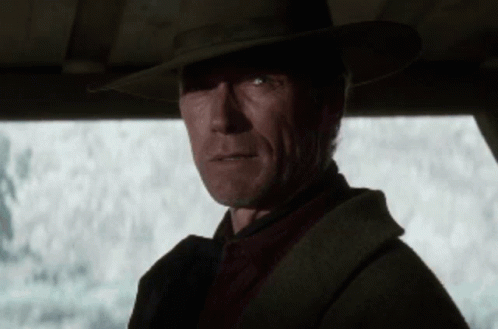Introduction:
Clint Eastwood, an actor and director, is often hailed as an American icon. With his portrayal of tough guy characters in spaghetti westerns and the Dirty Harry franchise, Eastwood became an international film star, admired and celebrated by audiences for decades. However, as a director, Eastwood has shown a different side, exploring the complexities and flaws of man. This blog post pays tribute to Clint Eastwood on his 93rd birthday by delving into two of his notable films, “Unforgiven” (1992) and “Gran Torino” (2008), which showcase his talent for working both in front of and behind the camera.
Unforgiven: Challenging Hero Archetypes and Examining Society’s Corruption

Unforgiven (1992).
In the film “Unforgiven,” Clint Eastwood aimed to illustrate the consequences of violence for both victims and perpetrators. He subverted the traditional hero archetype by portraying the flawed character of Bill Munny, an outlaw gunslinger with a soft spot for abused women. Through this character, Eastwood highlights the moral complexities that exist within supposedly heroic individuals. In contrast, Gene Hackman’s character, Sheriff Bill Dagget, initially perceived as a moral man, protects a rapist due to personal interests.
Eastwood’s writing and direction showcase the reversal of moral roles, revealing the corruption within civil institutions and society as a whole. Mise-en-scène, particularly the use of dark and gritty color palettes, along with symbolic imagery like an American flag desecrated by lightning, further emphasize this societal decay. Even as Munny triumphs over Dagget, the film concludes with Munny riding off into a storm, symbolizing his ongoing inner conflict and disillusionment with society. Eastwood’s departure from the typical “lone gunman riding into the sunset” archetype reflects his desire to explore the flaws of man rather than romanticize heroism.
Gran Torino: Redemption and Coming of Age

Gran Torino (2008)
In “Gran Torino,” Clint Eastwood presents a story of redemption during one’s twilight years. Eastwood portrays Walt Kowalski, an aging Korean War veteran living in a changing neighborhood. At first, Kowalski displays blatant racism and disdain towards the Hmong community that has moved into his predominantly Caucasian neighborhood. However, when he saves a young Hmong boy, Tao, from a gang initiation, Kowalski’s transformation from a bitter old man to a mentor and reluctant father figure begins.
Through dialogue and character development, Eastwood showcases Tao’s journey from a timid boy to a confident young man. Scenes at the local barber shop, where Tao learns “how guys talk,” provide both humor and insights into the characters’ growth. The Gran Torino itself serves as a metaphor for passing the torch from one generation to the next, representing manhood, rugged masculinity, and redemption through hard work. The film challenges initial perceptions by revealing the complexity of characters like Walt, who, despite his racist tendencies, sacrifices himself to protect Tao from the gang.
Conclusion:
Clint Eastwood’s films, “Unforgiven” and “Gran Torino,” demonstrate his ability to explore the complexities of manhood and society. “Unforgiven” defies Western tropes, focusing on the harsh realities of the old west and the moral dilemmas faced by flawed characters. In “Gran Torino,” Eastwood addresses themes of redemption, coming of age, and the transformation of a bitter old man into a mentor figure. Both films offer profound insights into the human condition and showcase Eastwood’s mastery as both an actor and director.
As we celebrate Clint Eastwood’s 93rd birthday, let us appreciate his contributions to the film industry, his portrayal of complex characters, and his commitment to telling stories that challenge conventional narratives. Clint Eastwood continues to captivate audiences, reminding us that the exploration of flawed individuals can lead to profound and thought-provoking cinema.

Happy Birthday To The Living Legend!
Works Cited:
- Deloria, Phillip J. “Review: ‘Unforgiven’.” The American Historical Review (1995): 1194-1198.
- Plantinga, Carl. “Spectacles of Death: Clint Eastwood and Violence in ‘Unforgiven’.” Cinema Journal (1998): 65-83.
- Redding, Art. “A Finish Worthy of the Start: The Poetics of Age and Modern Masculinity in Clint Eastwood’s ‘Gran Torino’.” Film Criticism (2014): 2-23.
